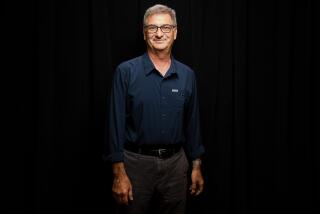Compost Bin Promotes Clean Perspective on Waste Disposal
About 250 earth-conscious Glendale residents looked fearlessly into the future of garbage this past weekend.
What they saw was clean-smelling, tidy and attractive. It generated no pollution, took up no space in landfills and demanded no fleet of noisy municipal vehicles to carry it away. It was a boon to the Earth.
But, most surprising, it had a lot in common with the garbage of the past.
In the old days, if you remember, people took care of their own garbage. I don’t mean the indigenous people, who tossed it behind their huts until the piles grew too offensive to endure, and then moved on to fresh surroundings.
I’m referring, actually, to the age of the back-yard incinerator. At one time, everyone had one. It was a tall masonry chamber with an iron fire door and a flame-arrester chimney. It was as unquestioned a part of domestic life as the steam iron and the milkman’s delivery door.
Whatever combustible waste the household produced was burned in a kind of family ritual. The first thing was to sort out all those things that would burn, such as newspapers, egg cartons and shopping bags. Other things--old shoes, broken heirlooms and clippings from the yard--went in the trash. The trash was a repetitive chore, of little intrinsic interest.
The incinerator, on the other hand, was stimulating, like the campfire of old. A child put in charge of it learned the properties of fire: what would burn and what would not, how to make many materials burn faster or more completely, and how to manage the effects of humidity.
Although I don’t recall the exact year, I suspect it was around 1960 that the back-yard incinerator was banned as a contributor to air pollution. The sanitary landfill--a term as lacking in spirit as the thing it describes--was then offered as the final solution to the immemorial question: What does man do with his trash?
I’m sure there were those who knew that the landfills would all be full some day and that even cities as mechanically progressive as Glendale would have to return to a form as homespun as the incinerator.
At last the cycle has closed.
On Saturday, Glendale held a public workshop at the Clark Community Center to re-introduce its residents to the self-reliant ways of back-yard trash disposal. In place of the incinerator, the city unveiled the back-yard compost bin.
As a special promotion, the city gave away about 250 of these bins. They came in four different styles. One was like a square pen of wooden slats. The other three were of molded plastic and resembled oddly shaped, oversized, bottomless trash cans.
Before the bins were handed out, several experts took turns describing the purpose and technique of back-yard composting. In general, the concept is that the homeowner--or even condominium dweller--sets up the bin in any sunny spot and feeds it a balanced blend of organic wastes, primarily yard clippings and food scraps.
The careful composter stirs the mixture from time to time as it cooks at about 150 degrees.
After a few weeks or months, a sifting of the lower layers yields a fine-grained residue that can be worked into the soil as amendment or laid above ground as mulch. The larger chunks go back to the bin to begin the next batch.
The similarity to the old incinerator was only too obvious, but the ethos was new. While the incinerator fed on the quick gratification of fire, the compost bin promotes a slow, clean, almost cosmic perspective on waste disposal.
In composting, old definitions fade away.
“Organic matter is a very valued material which feeds our soil, and really the term waste is a misnomer,” said John Roulac of Harmonious Technologies, distributor of the wooden-slat bin.
Composting can even be fun, in a mystical sort of way.
“My granddaughter now likes to take the kitchen scraps out of the sink into the magic box,” said Neil Turner, who was pushing a square plastic model with a trapdoor at the bottom to remove the product.
“It becomes like a pet,” Turner added. “I like to go out and see how he’s cooking.”
You might think, as I did, that the little bins handed out Saturday are mere toys or icons designed to prepare our thinking for future organic systems to be built on an economy of scale, as municipal engineers like to say.
It would seem that the refuse of an average house would fill up one of those bins in a week or two. But the speakers ascribed almost magical capacity to the little bins.
“I have friends who have been using one or two of these units for 2 1/2 years and they never filled it up,” said Rick Ryan, composting expert for TreePeople.
Afterward, in a private conversation, Roulac was even more expansive.
“When you put your material into a composting bin, it’s the great disappearing act,” he said. “Approximately 70% to 80% of yard waste is water. So the material just shrinks in volume. You can fill the bin up. It will shrink down. You can fill it up again.”
For those who missed the session, the city is repeating it Saturday at 10 a.m. and 1 p.m. There are still 150 free bins available.
You can still be the first on your block to own one.
More to Read
Sign up for Essential California
The most important California stories and recommendations in your inbox every morning.
You may occasionally receive promotional content from the Los Angeles Times.











